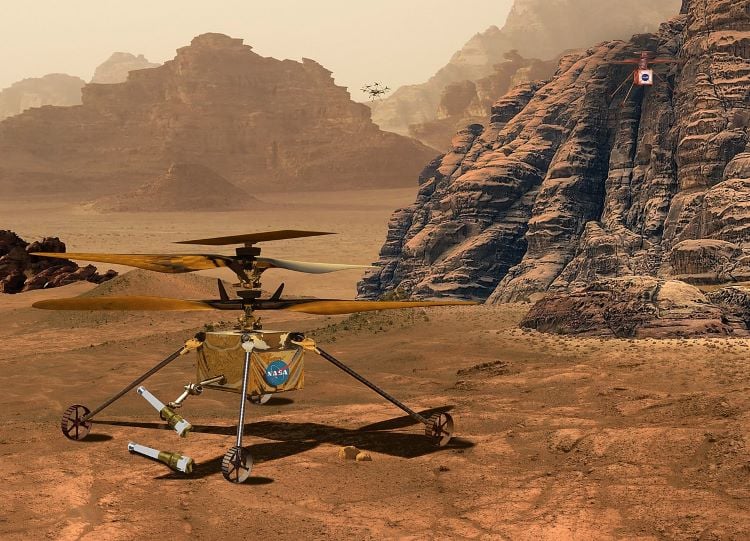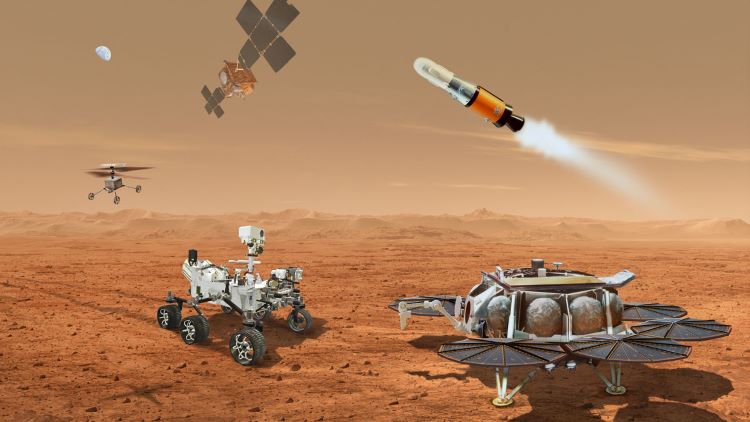While NASA’s Ingenuity Mars Helicopter continues to break records for both airspeed and altitude while it explores Jezero Crater on the Red Planet, NASA engineers back on Earth are hard at work testing carbon fiber blades for next-generation Mars helicopters that could exceed the performance of Ingenuity on future missions to Mars, specifically with the planned Mars Sample Return mission that NASA hopes to accomplish sometime in the 2030s.
"Our next-generation Mars helicopter testing has literally had the best of both worlds," Teddy Tzanetos, who is the project manager for Ingenuity and manager for the Mars Sample Recovery Helicopters, said in an official NASA statement. "Here on Earth, you have all the instrumentation and hands-on immediacy you could hope for while testing new aircraft components. On Mars, you have the real off-world conditions you could never truly re-create here on Earth."
These off-world conditions on Mars include surface atmospheric pressure and surface gravity that is less than one percent and one-third of Earth's surface, respectively. It is because of this significantly reduced surface pressure that Ingenuity's rotations per minute (rpm) are between 2,400 to 2,900 rpm to achieve flight on the Red Planet. This is significantly higher than on Earth, as helicopters typically only need 500 to 600 rpm to achieve flight.
The Ingenuity Mars Helicopter incorporates four carbon fiber blades organized into two counter-rotating rotors, meaning that rotate opposite to each other, spanning 1.2-meters (4-feet) across with the aforementioned rotating speed of between 2,400 to 2,900 rpm (rotations per minute). Additionally, Ingenuity also weighs in at approximately 1.8 kilograms (4 pounds) on Earth, but with Mars having approximately one-third the gravity Ingenuity weighs only 0.68 kilograms (1.5 pounds) on the surface of the Red Planet.
April 2021 video discussing the design and development of Ingenuity.For the next-generation Mars helicopters, NASA engineers at Jet Propulsion Laboratory (JPL) in Pasadena are constructing blades that are slightly more than 10 centimeters (4 inches) longer than Ingenuity's blades, along with exhibiting a separate design and increased strength, as well.
"We spun our blades up to 3,500 rpm, which is 750 revolutions per minute faster than the Ingenuity blades have gone," Tyler Del Sesto, who is the Sample Recovery Helicopter deputy test conductor at JPL, said in an official NASA statement. "These more efficient blades are now more than a hypothetical exercise. They are ready to fly."
One goal of these next-generation Mars helicopters could be on the joint NASA-ESA Mars Sample Return mission slated to occur sometime in the 2030s. This mission will encompass three parts: sample collection, sample retrieval, and a return mission. It is the sample retrieval mission that will involve the most equipment, including two Ingenuity-class helicopters tasked with collecting samples with a robotic arm that are currently being placed on the surface of Mars in Jezero Crater by NASA's Perseverance rover.
These sample retrieval helicopters will vary in design from Ingenuity in that they are planned to have a set of four wheels used to drive to the sample upon landing a few meters from them. Upon retrieval, the helicopters will fly to the Sample Retrieval Lander (SRL), which will then load the samples into the Mars Ascent Vehicle (MAV), which will launch the samples to low Martian orbit where they will return to Earth for analysis. Currently, Perseverance has collected a total of 23 samples with the goal of collecting 38 samples in the end.
As noted, Ingenuity continues to break records for both altitude and speed as it has completed a total of 66 flights as of this writing, which far exceeds the original plan of five flights over the course of a 30-day mission that began on April 19, 2021. Thus far, Ingenuity has achieved a maximum horizontal distance of 704 meters (2,309.71 feet), which it achieved on its 25thflight on April 3, 2022, and a maximum altitude of 24 meters (78.7 feet), which it achieved on its 61stflight on October 5, 2023.
How will these next-generation Mars helicopters help improve the science and engineering performed on the Red Planet in the coming years and decades? Only time will tell, and this is why we science!
As always, keep doing science & keep looking up!
 Universe Today
Universe Today

